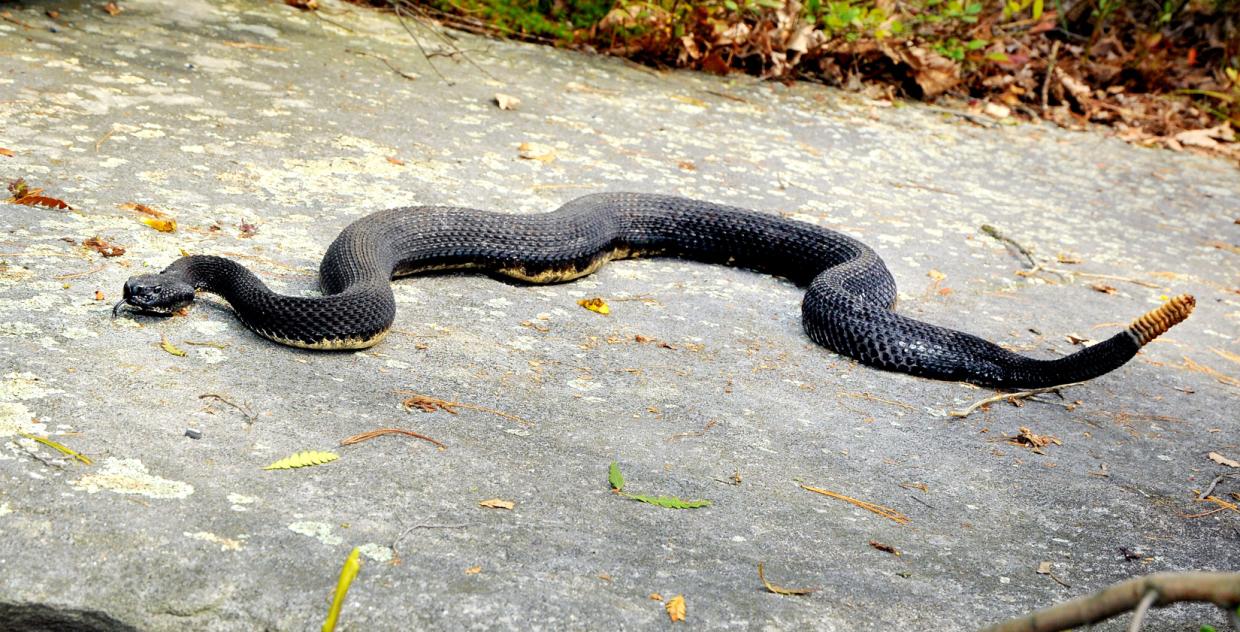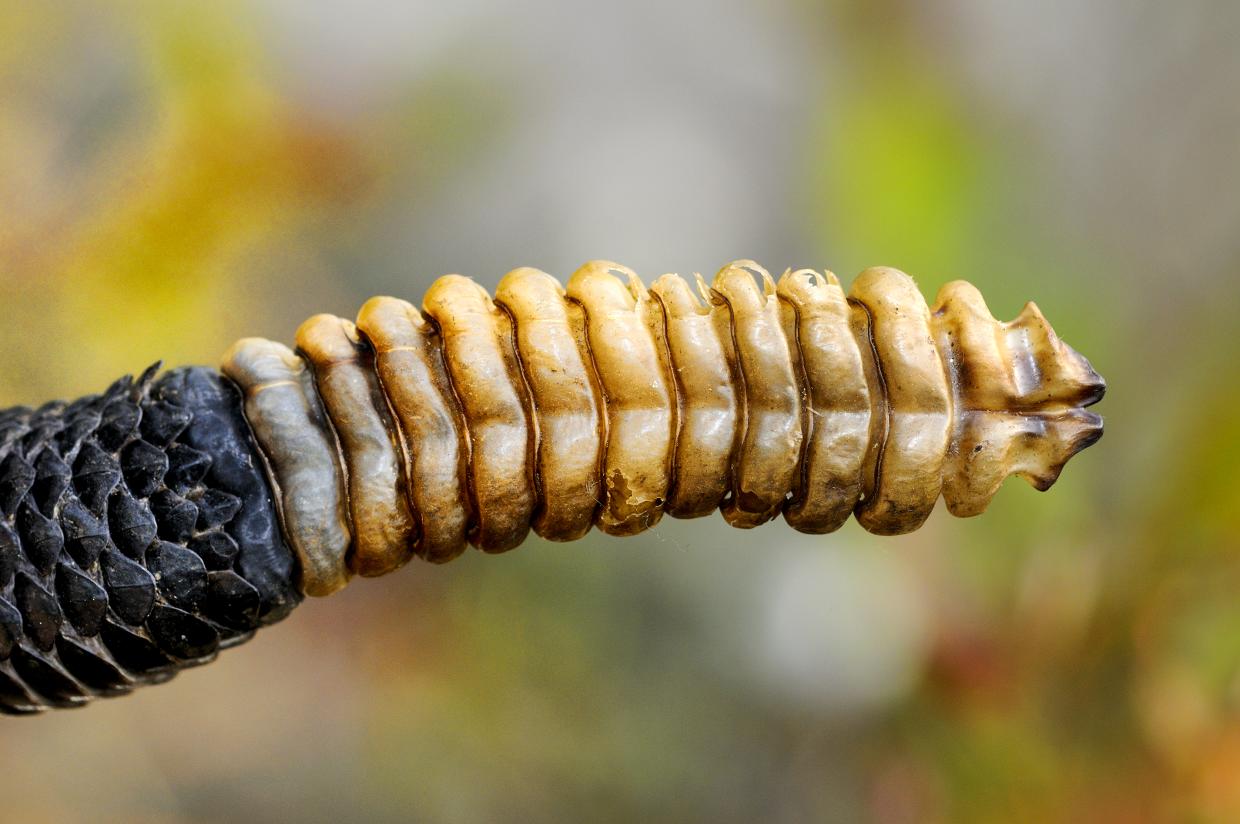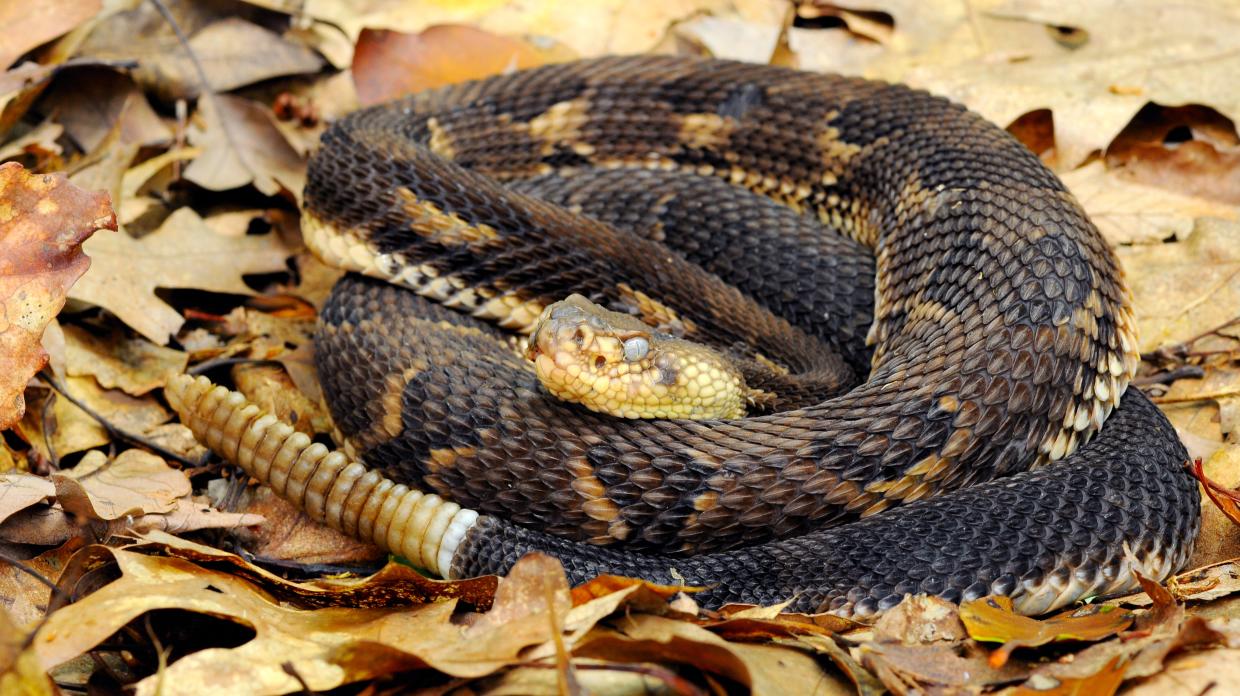Fast facts
Common name:: Timber rattlesnake
Scientific name: Crotalus horridus
Range in MA: Limited almost exclusively to western counties
Conservation status: Listed as endangered in Massachusetts
Fun fact: Add a new rattle segment each time they shed their skin.
Similar species: Northern watersnakes and milksnakes (both also have dorsal blotches, saddles, or bands); copperheads (the only other pit viper in Massachusetts, they are more reddish, have hourglass-shaped patterns on their bodies, and lack a rattle).
Identification tips: Look for a triangular head and actual rattle. Most other nonvenomous snake species, including milksnakes, can also wiggle their tails in leaves or brush to mimic the sound of a rattle.
Description
These large, heavy-bodied pit vipers have broad, triangular heads and extremely variable color patterns. Some are almost jet black. Others appear sulfur-yellow with black, brown, or rust-colored blotches, which are separated by cross bands on the back and sides.
Unlike any other rattlesnake species in North America, timber rattlers lack stripes or bands on their heads and faces, and their tails are solid black. Each time rattlesnakes shed their skin, they add a new rattle segment. If the snake still has the "pre-button" it was born with, the length of its rattle can indicate its approximate age. Timber rattlesnakes have keeled scales (a ridge protruding from the middle of each scale), giving them a rougher-skinned appearance.
Pits on each side of their heads contain sensitive nerves that react to radiant heat and help in detecting warm-blooded prey in darkness. Timber rattlesnakes can see well, but within a limited range, and they can see moving objects more easily than stationary ones. They are extremely sensitive to ground vibrations, which can help them find prey or avoid their own predators. Two well-developed, enlarged fangs conduct venom in the front of theirs mouths. These fangs fold against the roof and are covered by a sheath when their mouths are closed. They can control also how much venom they inject. In addition to their enlarged fangs, they have many curved smaller teeth on the palate and lower jaw.
Adults range from 36–60 inches; newborns are about 8–16 inches. Males usually reach about 2 pounds, while females average 1.3 pounds. No reliable external cues exist to help differentiate the sexes, but males often have longer tails than females.
If you see one
Because they are venomous AND endangered in Massachusetts, please maintain a safe, respectful distance. Do not handle or otherwise disturb them.
To help with conservation efforts, please submit your observations with us. Either:
- create an account in the Heritage Hub, or
- complete and mail a Rare Animal Observation Form for one-time observations.
Your reports provide critical information that informs future habitat management and wildlife conservation for future generations.
Habitat
Timber rattlesnakes range throughout the eastern United States and as far west as Texas and Wisconsin. All current northeast populations are small, declining, or completely extirpated. Their main habitats are mountainous terrains with steep ledges or rockslides close to forested areas and large populations of rodents. They hibernate communally, in underground crevices. They occasionally visit other habitats such as pine barrens, wetlands, fields, and pastures.
Once widespread across western, central, and northeastern Massachusetts, timber rattlers' lower reproductive rates and longer maturation periods have made their populations highly vulnerable. Today's statewide populations numbers only in the hundreds, scattered over a handful of ridges, hills, and mountains that offer the required winter habitat of rocky, fractured slopes with open southern or western exposures.
Life history
Massachusetts timber rattlesnakes are active from mid-April to mid-October. For several weeks after emerging from hibernation, they rarely move or eat, basking on ledges all day. While they remain concentrated near their hibernacula, some courtship and mating take place. Depending on weather, they re-enter dens between early September and late October. Timber rattlesnakes mate both in spring and autumn, after which they move an average of one mile from their den.
In summer, males use woods where the forest canopy is closed. Females stay in open forest or field edges where temperatures are higher. Pregnant females move the least and remain closest to dens. Females retain their eggs in their bodies, and young are born alive, in a process known as ovoviviparity. Between late August and mid-September, 4–5 months after mating, 5–9 young are born. They stay near their nursery areas for several weeks until after shedding their first skins. Each is equipped with venom, fangs, and a single, tiny rattle segment called a pre-button. Young are nourished by egg yolk retained in their bodies, and they grow rapidly in their first few weeks of life. They follow a trail left by their mother or other adult snakes toward their wintering dens.
Diets consist almost exclusively of warm-blooded prey such as mice, chipmunks, squirrels, rabbits, and birds. Rattlesnakes are considered ambush predators.
Bites require immediate medical attention, but they are very rare, and they are even more rarely fatal. Most snake bites from timber rattlers are due to illegal or otherwise ill-advised handling or harassment.
Management and conservation
 Timber rattlesnakes have sustained the largest decline of any native reptile species in Massachusetts in the past 150 years. Populations collapsed by the late 1800s, due not only to deforestation but also to deliberate eradication efforts supported by bounty systems.
Timber rattlesnakes have sustained the largest decline of any native reptile species in Massachusetts in the past 150 years. Populations collapsed by the late 1800s, due not only to deforestation but also to deliberate eradication efforts supported by bounty systems.
Today's few remaining populations in Massachusetts remain at very high risk, due to a diverse array of factors and threats. These include vehicle mortality, incidental and intentional killing, harassment, illegal poaching by collectors, and increased recreational visitation to new or unsanctioned trails and vistas. Populations are further threatened by natural sources of mortality and by7 an emerging, episodic fungal pathogen.
MassWildlife continues to work actively with key partners - such as the Department of Conservation and Recreation, Department of Transportation, Environmental Police, land trusts, private landowners, and fellow scientists - to identify the most critical threats and prioritize and implement the most urgent actions. These include:
- protecting key parcels of privately-owned land
- redirecting recreational public access around and away from sensitive areas
- reducing road mortality through seasonal evening road closures
- improving outreach to towns that have rattlesnake populations (including neighboring landowners)
- strengthening law enforcement resources
- increase professional monitoring, following standardized protocols

